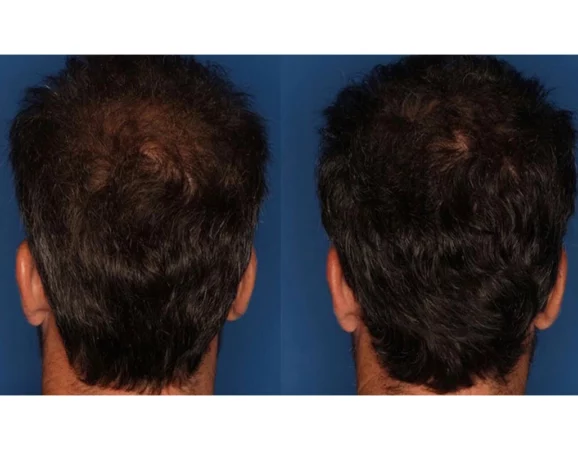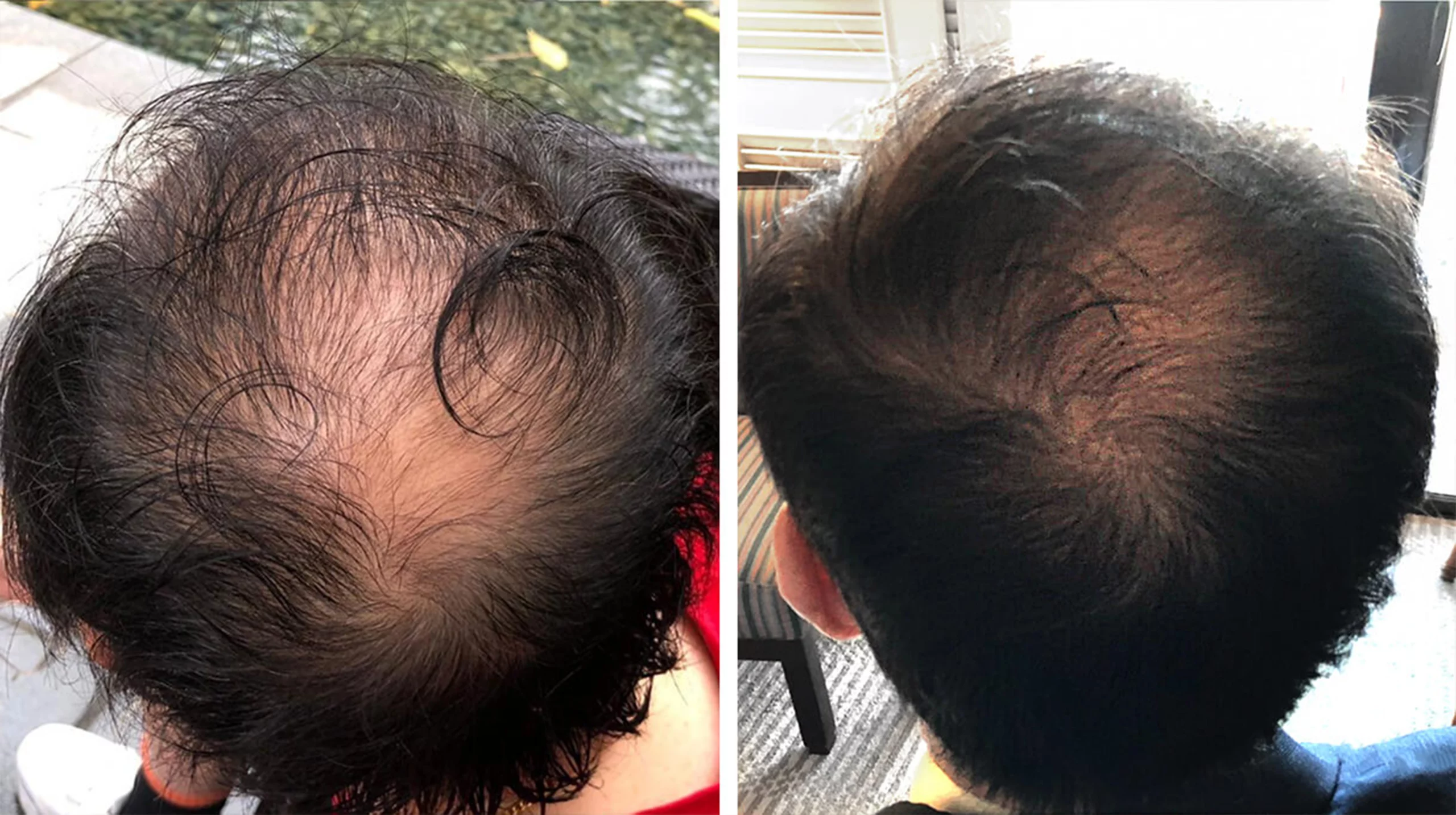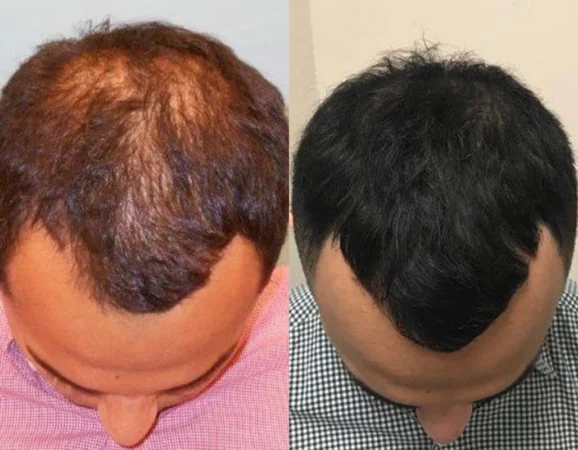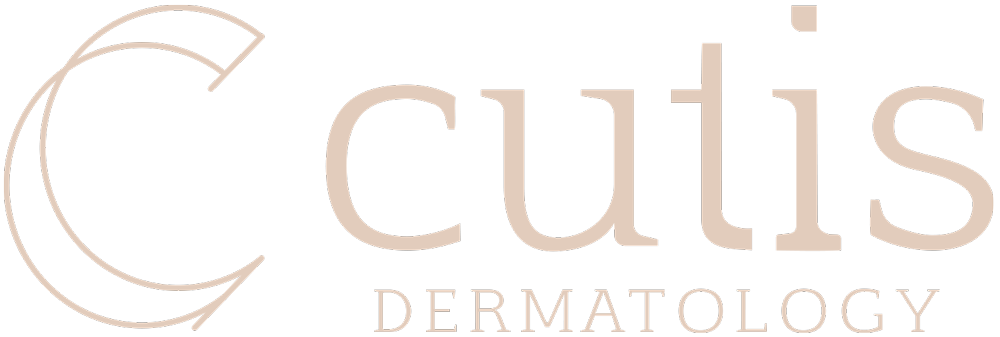Female hair loss, also known as androgenic alopecia, is the most common cause of hair loss in women. It is a progressive hereditary condition that affects women, usually after menopause. Early diagnosis & timely management will markedly reduce hair fall. In most cases a dermatologist will be able to grow your hair back.
Key Points
- Female pattern hair loss is a progressive hair loss condition, also known as androgenic alopecia.
- It is a hereditary condition
- This condition usually affects women after menopause
- Treatment works best when it is started at the first sign of hair loss.
- Therapy aims to slow hair loss progression & in most cases regrow hair
Female Hair Loss at a glance
Our results speak for themselves

Before
After

Platelet derived plasma is most successful
when initiated early
Ask us more about this treatmant
Preferred Consultation

Before
After

Ask us more about this treatmant
Preferred Consultation

Before
After

Growth factor injections for baldness. Four sessions, spaced
one month apart
Ask us more about this treatmant
Preferred Consultation
FAQs
What is female pattern hair loss?
Female pattern hair loss, known as androgenic alopecia, is the most common cause of hair loss in women. It is a progressive condition that slows new hair growth and results in finer, thinner hair.
Most women experience female pattern hair loss in their 40s, the diffuse thinning of hair is more noticeable after menopause but the role of hormones, both androgen and estrogen, is not clear. Female pattern hair loss is considered a hereditary condition and related to your genes.
Will hair loss worsen with time?
Although it is normal for your scalp to lose 50-100 hairs a day, female pattern hair loss is more severe, & best to be treated early to get the best results.
Women aren’t likely to become completely bald like men, but hair loss is progressive. Female pattern hair loss can also be confused with chronic telogen effluvium due to similarities in the symptoms, but they differ in the management and treatment.
What causes female pattern hair loss?
Female pattern hair loss is hereditary. It is characterised by a shorter hair cycle, & miniaturization of hair follicles. Essentially hairs will begin to shrink until they can no longer grow hair, after this phase the hair loss can’t be reversed.
Since female pattern hair loss usually happens after menopause and is unlikely to happen before, hormones are thought to be a related cause, but it is still uncertain.
It is also associated with androgen-related conditions like polycystic ovary syndrome (PCOS) in which androgen hormonal levels are elevated. Your doctor will order tests for your androgen level if you have any other androgen-related symptoms.
What are the symptoms of female pattern hair loss?
The hair loss pattern looks different in males and females. Females tend to have widespread thinning of the hair, especially on the crown of the scalp. While the front hairline remains normal, the hair loss affected areas are thinner and shorter compared to normal hair.
Female pattern hair loss onset of symptoms happens later compared to male pattern hair loss. Dermatologists notice the symptoms start in the 30s or 40s in women, usually after menopause. While in male pattern hair loss, men experience the symptoms in their 50-60s.
There are no scalp symptoms, other than hair loss, are associated with female pattern hair loss. However, psychological problems can result from hair loss like depression or anxiety, impacting the quality of life. Low self-esteem, introversion, and negative body image are very common in women who have female pattern hair loss.
How is it diagnosed?
Dermatologists usually diagnose female pattern hair loss with:
- History of gradual thinning or increased shedding of the hair.
- Family history of hair loss
- Clinical examination to confirm the diagnosis
- Diagnostic blood & hormonal tests like thyroid hormones, androgens, iron, or other substances that could affect hair growth.
The scalp often looks normal with no symptoms, but your dermatologist will examine the pattern of hair loss. The diagnostic blood tests are done to make sure there isn’t any underlying cause of your hair loss.
Although androgen levels are normal in most female pattern hair loss cases, some may have elevated androgen levels that could lead to female pattern hair loss. However, these cases present with other hormonal-related symptoms like acne and irregular menstruation.
How do dermatologists treat female pattern hair loss?
Dermatologists recommend early management to improve the results of the treatment, halt progression of hair fall, & in many cases regrow hair.
The aim of the treatment is to focus on slowing or stopping the progression of hair loss. There are many treatment options, so ask your dermatologist what the best option for you is.
What is minoxidil & how does it work?
Studies found that 2% and 5% minoxidil help in female pattern hair loss to slow down hair loss progression & increase hair growth. It is applied daily, and you start to see the results in 6 to 12 months. In the initial use of minoxidil, the hair will start falling before giving the effect. It works by increasing the duration of anagen, meaning it prolongs the hair cycle.
Continuous use of minoxidil is recommended for a lasting effect, as any benefit will only be maintained for as long as the treatment is used.
What are the side effects of minoxidil?
The side effects of minoxidil are seen at the site of application, like:
- Dryness
- Redness
- Scaling and/or itchiness
- Unwanted hair growth in different areas other than the scalp
Avoid applying minoxidil in other areas than the scalp as it would get you unwanted facial hair growth. Oral side effects include dizziness & oedema.
Products

O Cosmedics cleansing range
$63.00-$64.00

O Biotics 3D Hyaluronic Serum
From $97.00
Dr Esh, an international hair expert, consults at Cutis Dermatology Brisbane. She has one of the highest success rates of growing back your own hair with medical therapy.
What are other off label anti-hormonal drugs for hair loss?
Studies have shown that finasteride and dutasteride are useful in female pattern hair loss, as they also block androgen production. They help hair regrowth and slow the progression.
Their side effects are related to their hormonal changes, like hot flushes and decreased sex drive. In Australia, these drugs are off label, you will need to discuss therapy with your dermatologist.
What supplements can be helpful for treating hair loss?
Iron, biotin, and folic acid supplements are also options in case of hair loss due to their deficiency. These supplements may take a longer time to show results, but they promote hair growth and thickness.
Other studies also found positive results when taking omega 3 and omega 6 fatty acids. They can give your hair a thick, full look, but check with your doctor before taking any supplements.
Can hair transplantation reverse female balding?
Hair transplantation can give a permanent solution to female pattern hair loss. A transplant surgeon will implant hair follicles from the sides or the back of the scalp to your bald areas. It’s much harder in female pattern baldness as hair loss is diffuse.
The two main factors to consider prior to surgical intervention is –
- Optimal medical therapy to halt further progress
- Has the donor site got enough density to pull this off.
Can lasers & light therapy help?
Laser combs and helmets might be useful to increase hair growth. These devices use light therapy to stimulate the follicles for hair regrowth.
We also use thulium lasers, usually in conjunction with autologous platelets. Be guided by your dermatologists.
What are other cosmetic methods to disguise hair loss?
Wigs and hair extensions can help to disguise the look of female pattern hair loss. They can usually last for 6-9 months and give a natural look. Some of them are even easy to style and come in different shapes and styles.
Sprays also can camouflage your hair loss as they contain pigmentation that could give a fuller look. However, they don’t last long.
Is female pattern hair loss preventable?
Female pattern hair loss isn’t preventable, however, early detection can markedly slow it down. Consistent & early treatment by a dermatologist can stop hair loss and help regrow some weak hair follicles.


